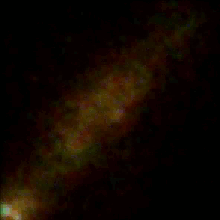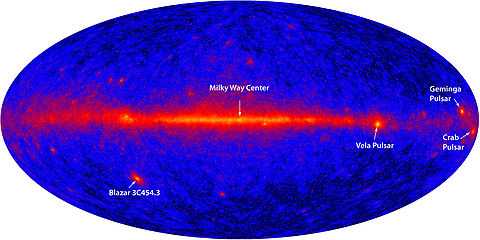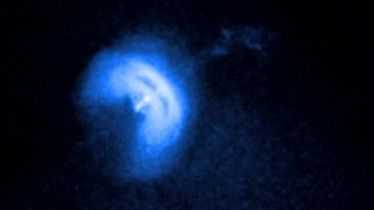Vela Pulsar
| Observation data Epoch J2000 Equinox J2000 | |
|---|---|
| Constellation | Vela |
| Right ascension | 08h 35m 20.65525s |
| Declination | −45° 10′ 35.1545″[1] |
| Apparent magnitude (V) | 23.6 |
| Astrometry | |
| Distance | 959+248 −163 ly (294+76 −50[2] pc) |
| Other designations | |
The Vela Pulsar (PSR J0835-4510 or PSR B0833-45) is a radio, optical, X-ray and gamma-emitting pulsar associated with the Vela Supernova Remnant in the constellation of Vela.
Supernova origins
The association of the Vela pulsar with the Vela Supernova Remnant, made by astronomers at the University of Sydney in 1968,[3] was direct observational proof that supernovae form neutron stars.
Characteristics
It spins 11.195 times per second[4] (i.e. a period of 89.33 milliseconds—the shortest known at the time of its discovery) and the remnant from the supernova explosion is estimated to be travelling outwards at 1,200 km/s (750 mi/s).[5] It has the third brightest optical component of all known pulsars (V = 23.6 mag)[6] which pulses twice for every single radio pulse. The Vela pulsar is the brightest persistent object in the high energy gamma ray sky.
Vela X
The pulsar is occasionally referred to as Vela X, but this is a separate phenomenon. A radio survey of the Vela-Puppis region was made with the Mills Cross Telescope in 1956-57 and identified three strong radio sources: Vela X, Vela Y, and Vela Z. These sources are close to the entirely separate Puppis A supernova remnant, which is also a strong X-ray and radio source.[7]
Studies conducted by Kellogg et al. with the Uhuru spacecraft in 1970-71 showed Vela X and the Vela pulsar to be separate but spatially related objects. The term "Vela X" was used to describe the entirety of the supernova remnant.[8] Weiler and Panagia established in 1980 that Vela X was actually a pulsar wind nebula, contained within the fainter supernova remnant and driven by energy released by the pulsar.[9]
Neither the pulsar nor either of the associated nebulae should be confused with Vela X-1, a nearby but unrelated high-mass X-ray binary system.
Gallery
-

Cycle of pulsed gamma rays from the Vela pulsar
-

Position of the Vela Pulsar in the Milky Way
-
Video of Vela's particle jet
References
- ↑ "Vela pulsar". SIMBAD. Retrieved 9 January 2013.
- ↑ Caraveo, P. A.; De Luca, A.; Mignani, R. P.; Bignami, G. F. (November 2001). "The Distance to the Vela Pulsar Gauged with Hubble Space Telescope Parallax Observations". Astrophys. J. 561 (2): 930–937. arXiv:astro-ph/0107282. Bibcode:2001ApJ...561..930C. doi:10.1086/323377.
- ↑ Large, M. I.; Vaughan, A. E.; Mills, B. Y. (October 1968). "A Pulsar Supernova Association?". Nature 20 (5165): 340–341. Bibcode:1968Natur.220..340L. doi:10.1038/220340a0.
- ↑ Manchester, R. N.; Hobbs, G. B.; Teoh, A.; Hobbs, M. (August 2005). "ATNF Pulsar Catalogue: J0835-4510". The Astrophysical Journal 129: 1993–2006. Bibcode:2005yCat.7245....0M.
- ↑ Lyne, Andrew G.; Graham-Smith, Francis (1998). Pulsar Astronomy (2nd ed.). Cambridge University Press. ISBN 0-521-59413-8.
- ↑ Mignani, R. P.; Zharikov, R. P.; Caraveo, P. A. (October 2007). "The Optical Spectrum of the Vela Pulsar". Astronomy and Astrophysics 473 (3): 891. arXiv:0707.2036. Bibcode:2007A&A...473..891M. doi:10.1051/0004-6361:20077774.
- ↑ Rishbeth, H. (December 1958). "Radio Emission from the Vela-Puppis Region". Australian Journal of Physics 11 (4): 550–563. Bibcode:1958AuJPh..11..550R. doi:10.1071/PH580550.
- ↑ Kellogg, E.; Tananbaum, H.; Harnden, F. R., Jr.; Gursky, H.; Giacconi, R.; Grindlay, J. (August 1973). "The X-ray Structure of the Vela X Region Observed from Uhuru". The Astrophysical Journal 183: 935–940. Bibcode:1973ApJ...183..935K. doi:10.1086/152279.
- ↑ Weiler, K. W.; Panagia, N. (October 1980). "Vela X and the Evolution of Plerions". Astronomy and Astrophysics 90 (3): 269–282. Bibcode:1980A&A....90..269W.
External links
| Wikimedia Commons has media related to Vela Pulsar. |
- Vela Pulsar at SIMBAD
- Vela Pulsar Glitch Caught 2004/07/07
- Chandra Reveals a Compact Nebula Created by a Shooting Neutron Star
- Firehose-Like Jet Observed In Action
- New Chandra Movie Features Neutron Star Action
- Sound of Vela Pulsar — recorded by Jodrell Bank Observatory
Coordinates: ![]() 08h 35m 20.65525s, −45° 10′ 35.1545″
08h 35m 20.65525s, −45° 10′ 35.1545″
| ||||||||||||||||||||||||||

